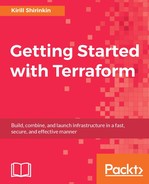Amazon Web Services is a cloud offering from Amazon, an online retail giant. Back in early 2000s, Amazon invested money in an automated platform, which would provide services for things such as network, storage, and computation to Amazon developers. Developers then don't need to manage underlying infrastructure. Instead, they would use provided services via APIs to provision virtual machines, storage buckets, and so on.
The platform, initially built to power Amazon itself, was open for public usage in 2006. The first released service was Simple Queue Service (SQS), followed by the two most commonly used AWS services—Simple Storage Service (S3) and Elastic Compute Cloud (EC2) that were released and anyone could pay to use them.
Fast forward 10 years. AWS now has over 70 different services, covering practically everything modern infrastructure would need. It has services for virtual networking, queue processing, transactional e-mails, storage, DNS, relational databases, and many, many others. Businesses such as Netflix completely moved away from in-house hardware and instead are building new types of infrastructure on top of cloud resources, getting significant benefits in terms of flexibility and cost-savings, and focusing on working on a product, rather than scaling and maturing own data center. For more information, refer to the following URL:
With such an impressive list of services, it becomes increasingly hard to juggle all involved components via AWS Management Console: the in-browser interface for working with AWS. Of course, AWS provides APIs for almost every service it has, but once again, the number and intersection of them can be very high, and it only grows as you keep relying on the cloud. This led exactly to the set of problems, discussed in Chapter 1, Infrastructure Automation, you end up either with intense ClickOps practices, or you script everything you can.
These problems make AWS a perfect candidate to explore Terraform, as we can fully understand the pain caused by direct usage of its services. Of course, AWS is not free to use, but luckily for a long time now, they provide Free Tier. Free Tier allows you to use lots (but not all) services for free with certain limitations. For example, you can use a single EC2 instance for 750 hours a month, for 12 months, for free, as long as it has the t2.micro type.
Let's create a brand new AWS account for our Terraform learning goals:
- Open https://aws.amazon.com/free and click on CREATE A FREE ACCOUNT.
- Follow the on-screen instructions to complete registration.
